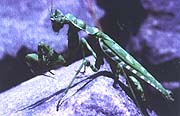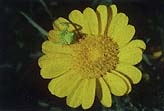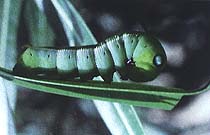DISAPPEARING ACTS
nature's camoflage artists
Text and pictures by Marijcke Jongbloed
It was a short time after my arrival in Arabia, about ten years ago, that I first became interested in the wonderful insects and arachnids of this area. Next to the hospital where I worked was a drip-irrigated plantation of ornamental trees and shrubs. Between the regimental rows of cultivated plants a wide variety of weeds and grasses grew. In a small patch of ground, not more than 200 square metres in area, I eventually discovered over 60 species of plants, some of which I have not seen anywhere else since then. It was while taking photographs of these wild plants and their seeds that I came across the insects that thrived in this unusually verdant habitat.
Disappearing Moth
One of the first to attract my attention was a tiny day-flying moth that appeared to be white as it fluttered from plant to plant. I was keen to photograph it but every time it settled down it seemed to disappear in front of my eyes. Each time that I approached the place where it had apparently dissolved into thin air it magically reappeared, taking off again from its sandy or grassy perch with its conspicuous fluttering white wings. It took many hours of patience, not to mention several litres of perspiration, before I had the pictures that I had set out to take. To my surprise it transpired that the moth was in fact strongly coloured with red and black polka dots on a white background. Such an apparently conspicuous pattern hardly seemed to be a good basis for the magnificent camouflage had almost thwarted my photographic efforts. Surprisingly however, when this moth sits on sand it becomes well nigh invisible since the pattern of dots break up the outline of the insect, rendering it virtually impossible to distinguish until it moves.
A few months later I found the caterpillars of this extraordinary moth (Utetheisa pulchella) on a Crotalaria bush, and they had the same basic coloration as the parental form described above. However, in the case of the caterpillar, the colouring did not function as a form of camouflage. In fact, the caterpillars were so blatantly obvious among the green branches that I suspect that the bright colours served as warning coloration, suggesting to potential predators that they were either poisonous or foul-tasting.
Twig or Stick
Stick insects, members of the order Phasmida, were also well represented in my lunch-time recreation area. In fact, I had never seen a stick insect in the wild until I found one there. Since that early encounter I have come across three or more different species of stick insects in the Emirates.
A very common, but always fascinating insect is the towerhead grasshopper (Truxalis procera). With its green and straw coloured limbs it is amazingly hard to see when it hides in vegetation. There is another variety of this insect - it is beige over its entire body, without any green parts. It may prefer sandy or stony areas where its colour form blends with the background.
 Magnificent
Mantis
Magnificent
Mantis
Among the mantises there are many more examples of excellent camouflage. The very colourful striped mantis (Blepharopsis mendica) which is so easy to see when it sits on a rock, disappears completely when hiding among the branches of a Euphorbia bush. The tiny fairy mantis (Oxyothespis nilotica) has another advantage: it is so small that you can only really see it through the macro lens of a camera or with the aid of a magnifying glass. Of all the mantis species however my favourite one has so far eluded efforts at identification. The first time I saw it was on a Tamarix tree so I named it the "Tamarix mantis". Its camouflage worked so well that I did not even realise that I had photographed it until my film was developed! Having not focused directly on the extraordinary insect it does not feature prominently on the resulting slide, but the picture serves perfectly to illustrate how closely it resembles a spray of tamarisk flowers!
Predators like mantises use their camouflage for two purposes: protection against predators and disguise against their own prey. This is also the case with the two large insect predators of the wadis: the giant water bug (Lethocerus niloticus) and the water scorpion (Laccotrephes fabricii). On numerous occasions I have encountered a pond within a wadi which, on first investigation, seemed to be devoid of animal life. One only had to sit down quietly however and to wait patiently for a few minutes before the water seemed to become alive. First the fishes start to emerge from below overhanging rocks or grasses, then the backswimmers and whirligigs resume their frantic surface activities. Next a large leaf floats by - but if you try to pick it up it bites! At least, this is the case if it is the giant water bug - I have no records of biting water scorpions as yet.
 Spiders:
Masters of Camouflage
Spiders:
Masters of Camouflage
The masters of camouflage however are the spiders. Every summer the sunflowers in my garden are host to a small yellow crab spider. During the first year my encounters were all accidental but now that I know what to look for I can find it quite easily. I have frequently observed it as it lies in wait for bees to visit the flowers. Despite the fact that the bees are four times its size it kills them easily and drags them to the underside of the flowers where it feasts on its prey's body fluids. The male crab spider, speckled brown in colour, is even smaller than the female, not more than two millimetres in diameter and it apparently has a different hunting strategy. The easiest time to distinguish these strange spiders is during their mating behaviour when the darker coloured male is astride the yellow camouflaged female's back. One conundrum which I have not yet solved is what happens to these sunflower inhabiting spiders when the sunflowers in my garden are no longer in flower?
The absolute master of camouflage that I have ever encountered was discovered hiding under a piece of plywood lying on the sand. As usual, when we are looking for hidden creatures, we turned over the plywood and immediately a spider scuttled away. If it had not moved we would never have seen it. Its speckled body and legs had the exact same colours as the grains of sand on which it rested. Later, I regretted that I had not taken another photograph after placing the spider on a contrasting background. It would have been interesting to see precisely with what colours and patterns its exquisite camouflage was achieved.
 Startling
Blue Eyes
Startling
Blue Eyes
Even relatively large insects such as the huge caterpillar of the oleander hawk moth can be difficult to detect among the leaves of their host plants. It is only when one discovers the damage done to carefully cultivated shrubs that the search begins for the culprit. And when you find it, and marvel at its delicate beauty, it is easier to forgive its sins. Potential predators other than aesthetically sensitive humans, such as birds for example, are met with a sharp display of warning coloration if they venture too close. Even when you know what to expect the sudden appearance of enormous eyes and the split second transformation of a peacefully munching long caterpillar into a scrunched up green ball with huge staring blue eyes is startling.
As long as there are plants to study, I shall enjoy the insect side-show for its rare beauty and fascinating variety.
Contents | News | Book Reviews | Back Issues
| Forum |
Subjects |
Search | Current Issue | Subscribe
Arabian Wildlife. Volume 2, Number 1